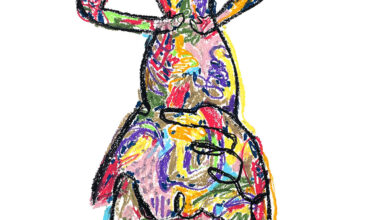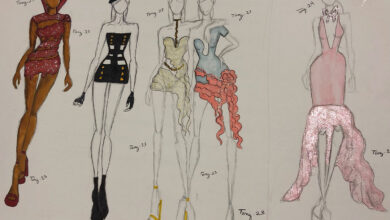There are still a few days to rediscover and explore Yohji Yamamoto’s creations at London’s Victoria & Albert Museum.
Text by Anna Battista
 In Wim Wenders’ film about Yohji Yamamoto Notebook on Clothes and Cities (1989), the designer is often shown leafing through the pages of Auguste Sander’s book Man of the Twentieth Century.
In Wim Wenders’ film about Yohji Yamamoto Notebook on Clothes and Cities (1989), the designer is often shown leafing through the pages of Auguste Sander’s book Man of the Twentieth Century.
In the movie Yamamoto states that in the past you could guess someone’s profession and background just by looking at their faces and clothes, something that is not possible anymore because in modern cities people tend to look more or less the same. Fascinated by Yamamoto’s passion for this book, Wenders identified three strong dichotomies in his world: fluid Vs solid; fleeting Vs permanent and fugitive Vs stable.
In a way these dichotomies reappeared also in Yamamoto’s Spring/Summer 2012 menswear collection with designs mainly based on large volumes, dual-layer trousers and jackets characterised by loose silhouettes that mixed traditional tailoring with modernly fluid and timeless shapes.
Yet it’s impossible not to walk through the retrospective (though Yamamoto doesn’t really like this term…) dedicated to the Japanese designer currently on at London’s Victoria & Albert Museum without realising that, while Wenders wasn’t fluent in fashion jargon when he shot the film, he perfectly managed to identify some key elements in Yamamoto’s universe.
The exhibition is mainly concentrated in a large room on the ground floor of the museum, with further designs scattered in different galleries to spark up a sort of dialogue with the art works surrounding them.
In the main exhibition space a video showing Yamamoto’s former teacher Ms Kosugi looking at his sketches, retraces Yamamoto’s career from his early training at the Bunkafukuso Gakuin School of Fashion in Tokyo.
The designer – who also spent some years working with his mother Fumi, a seamstress and a vitally important figure in his career – set up his company in 1972, launching his first collection five years later.
Yamamoto’s story then unravels through early catalogues with images shot by Paolo Roversi, Max Vadukul, Nick Knight and Inez Van Lamsweerde and Vinoodh Matadin and videos of catwalk shows or clips showing Yamamoto’s costumes for Tristan and Isolde (1993), directed by Heiner Müller and conducted by Daniel Barenboim, for Pina Bausch Dance Company’s 25th anniversary or for Takeshi Kitano’s films Brother (1999) and Dolls (2002).
Yamamoto’s fans will find particularly interesting the clips showing his Spring/Summer 1995 designs based on traditional Japanese dying techniques (yuzen and shibori), or the ones relating to his S/S 1999 collection in which he tackled issues of identity in garments in which bride and groom merged into each other.
Displays like the ones dedicated to his more commercial collaborations with Adidas or Hermès are alternated to spaces for more alternative projects such as Yamamoto”s book My Dear Bomb, co-authored with Ai Mitsuda, and his music projects including “Well, I Gotta Go” (1991) and “Your Pain Shall Be Your Music” (1997).
In Wenders’ movie Yamamoto explained he is fascinated by fabrics and usually the first thing he does before starting a collection is picking the material that then inspires his shapes and silhouettes.

Exploring the men and women’s wear designs showcased in this space, visitors will understand better Yamamoto’s passion for fabrics and materials. The exhibition features indeed tailored pieces such as a green pleated coat (Autumn/Winter 1986-87) but also more original designs, like a long turquoise neoprene dress with open back and silk netting (A/W 1996-97) and a yellow strapless silk dress and oversized hat covered in draped silk (S/S 1997).
Asymmetric and deconstructed details prevail, and there are homages to Madame Grès in Yamamoto’s pleated dresses from his S/S 2005 collection, and to Balenciaga in a black ruffled cape and black dress with crinoline (S/S 1999).
There are echoes of Schiaparelli”s surrealism in a black oversized jacket with kimono sleeves and a black shirt under a skeleton-like structured cage corset, while a navy tailored overall matched with a navy forage cap with black netting (S/S 2003) calls to mind Thayaht”s “tuta” and the overalls worn by a group of women workers coming out of a factory pictured in one of the books of photographs Yamamoto leafs through in Wenders’ film.
One of Yamamoto’s favourite images from Man of the Twentieth Century portrays a young man, a gypsy with a forlorn expression wearing clothes characterised by a loose silhouette that often comes back in the striped pyjamas, the floral velvet suits and the blue and black tartan shirt with integrated oversized scarf-wrap showcased among the menswear designs.
Further menswear designs inspired by loose silhouettes, military attire, utility wear and manga characters such as “Candy”, can be admired in the Sculpture and the Ceramics Galleries, accompanied by Yamamoto’s statements and explanations (“When I started a men’s line in Paris, my message was very simple: let’s be outside of this. Let’s be far from our suits and ties. Let’s be far from businessmen. Let’s be vagabonds” – “I wanted people to wear my clothes for at least ten years, so I asked the fabric maker to make a very strong, tough finish. It’s very close to designing army clothing…”).
While gender is erased in Yamamoto”s androgynous designs exhibited on the landing of the British Galleries that betray behind their rigorous tailored shapes a passion for couture-like details, the female body is celebrated in his long white crêpe de chine sleeveless dress for Pina Bausch showcased in the V&A’s Norfolk House Music Room.
The best thing about the exhibition is the fact that the designs are not displayed under glass, but visitors can walk around them and study details such as textures, patterns and structures. Fabric – from cotton to velvet, silk and boiled wool – is definitely the main protagonist of this exhibition. “Fabric is everything,” once stated Yamamoto. “Often I tell my pattern makers, ‘Just listen to the material. What is it going to say? Just wait. The material will probably teach you something’.”
Walking through, analysing and exploring Yamamoto’s designs and their fabrics, fans will definitely remember the images from Notebook on Clothes and Cities and agree with Wenders’ final words as he films the designer and his team re-watching a tape of a catwalk show: “It was only here looking at these tired but content faces that I understood how Yohji’s tender and delicate language could survive in each of his creations (…) I looked at them like they were a kind of film crew and Yohji was the director shooting a never ending film. His images were not to be to be shown on the screen; if you sit down to watch his film you’d find yourself instead in front of that very private screen which any mirror that reflects your image can become. To be able to look at your own reflection in such a way that you can recognise and more readily accept your body, your appearance, your history – in short, yourself – seems to me the continuing screenplay of the friendly film by Yohji Yamamoto.”

“Yohji Yamamoto” is at the V&A until 10th July; “Yohji Making Waves”, showcasing Yamamoto’s 1998 white silk crinoline wedding dress suspended over water, is at The Wapping Project, London, until 14th July 2011.
With special thanks to artist Polona Dolzan, Assistant to Curator, for taking Zoot Magazine around the exhibition.




CATWALK IMAGES BY MONICA FEUDI
ALL IMAGES COURTESY V&A LONDON

















